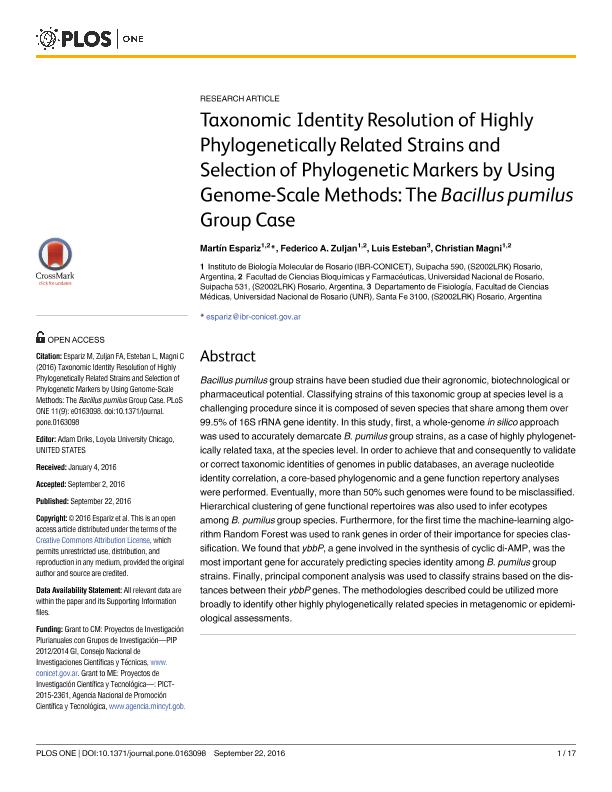Mostrar el registro sencillo del ítem
dc.contributor.author
Espariz, Martin

dc.contributor.author
Zuljan, Federico Alberto

dc.contributor.author
Esteban, Luis
dc.contributor.author
Magni, Christian

dc.date.available
2018-06-29T18:33:53Z
dc.date.issued
2016-09
dc.identifier.citation
Espariz, Martin; Zuljan, Federico Alberto; Esteban, Luis; Magni, Christian; Taxonomic identity resolution of highly phylogenetically related strains and selection of phylogenetic markers by using genome-scale methods: The bacillus pumilus group case; Public Library of Science; Plos One; 11; 9; 9-2016; 1-17; e0163098
dc.identifier.issn
1932-6203
dc.identifier.uri
http://hdl.handle.net/11336/50748
dc.description.abstract
Bacillus pumilus group strains have been studied due their agronomic, biotechnological or pharmaceutical potential. Classifying strains of this taxonomic group at species level is a challenging procedure since it is composed of seven species that share among them over 99.5% of 16S rRNA gene identity. In this study, first, a whole-genome in silico approach was used to accurately demarcate B. pumilus group strains, as a case of highly phylogenetically related taxa, at the species level. In order to achieve that and consequently to validate or correct taxonomic identities of genomes in public databases, an average nucleotide identity correlation, a core-based phylogenomic and a gene function repertory analyses were performed. Eventually, more than 50% such genomes were found to be misclassified. Hierarchical clustering of gene functional repertoires was also used to infer ecotypes among B. pumilus group species. Furthermore, for the first time the machine-learning algorithm Random Forest was used to rank genes in order of their importance for species classification. We found that ybbP, a gene involved in the synthesis of cyclic di-AMP, was the most important gene for accurately predicting species identity among B. pumilus group strains. Finally, principal component analysis was used to classify strains based on the distances between their ybbP genes. The methodologies described could be utilized more broadly to identify other highly phylogenetically related species in metagenomic or epidemiological assessments.
dc.format
application/pdf
dc.language.iso
eng
dc.publisher
Public Library of Science

dc.rights
info:eu-repo/semantics/openAccess
dc.rights.uri
https://creativecommons.org/licenses/by-nc-sa/2.5/ar/
dc.subject
B. Pumilus
dc.subject
Randomforests
dc.subject
Taxonomic Resulution
dc.subject.classification
Otras Ciencias Biológicas

dc.subject.classification
Ciencias Biológicas

dc.subject.classification
CIENCIAS NATURALES Y EXACTAS

dc.title
Taxonomic identity resolution of highly phylogenetically related strains and selection of phylogenetic markers by using genome-scale methods: The bacillus pumilus group case
dc.type
info:eu-repo/semantics/article
dc.type
info:ar-repo/semantics/artículo
dc.type
info:eu-repo/semantics/publishedVersion
dc.date.updated
2018-06-26T22:23:50Z
dc.journal.volume
11
dc.journal.number
9
dc.journal.pagination
1-17; e0163098
dc.journal.pais
Estados Unidos

dc.journal.ciudad
San Francisco
dc.description.fil
Fil: Espariz, Martin. Consejo Nacional de Investigaciones Científicas y Técnicas. Centro Científico Tecnológico Conicet - Rosario. Instituto de Biología Molecular y Celular de Rosario. Universidad Nacional de Rosario. Facultad de Ciencias Bioquímicas y Farmacéuticas. Instituto de Biología Molecular y Celular de Rosario; Argentina
dc.description.fil
Fil: Zuljan, Federico Alberto. Consejo Nacional de Investigaciones Científicas y Técnicas. Centro Científico Tecnológico Conicet - Rosario. Instituto de Biología Molecular y Celular de Rosario. Universidad Nacional de Rosario. Facultad de Ciencias Bioquímicas y Farmacéuticas. Instituto de Biología Molecular y Celular de Rosario; Argentina
dc.description.fil
Fil: Esteban, Luis. Universidad Nacional de Rosario. Facultad de Ciencias Médicas; Argentina
dc.description.fil
Fil: Magni, Christian. Consejo Nacional de Investigaciones Científicas y Técnicas. Centro Científico Tecnológico Conicet - Rosario. Instituto de Biología Molecular y Celular de Rosario. Universidad Nacional de Rosario. Facultad de Ciencias Bioquímicas y Farmacéuticas. Instituto de Biología Molecular y Celular de Rosario; Argentina
dc.journal.title
Plos One

dc.relation.alternativeid
info:eu-repo/semantics/altIdentifier/doi/http://dx.doi.org/10.1371/journal.pone.0163098
dc.relation.alternativeid
info:eu-repo/semantics/altIdentifier/url/http://journals.plos.org/plosone/article?id=10.1371/journal.pone.0163098
Archivos asociados
